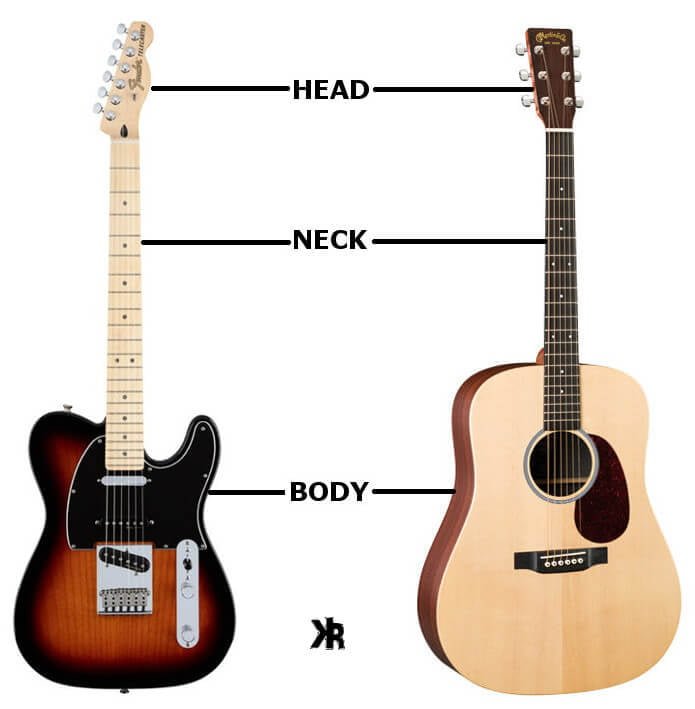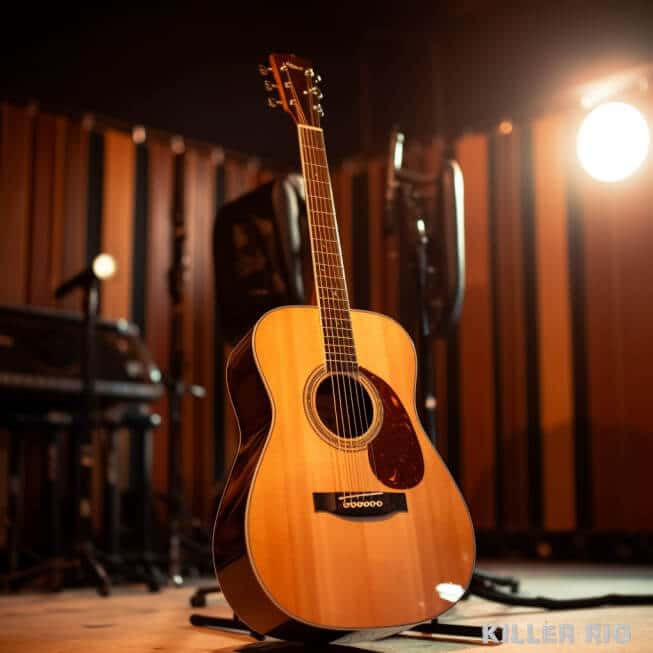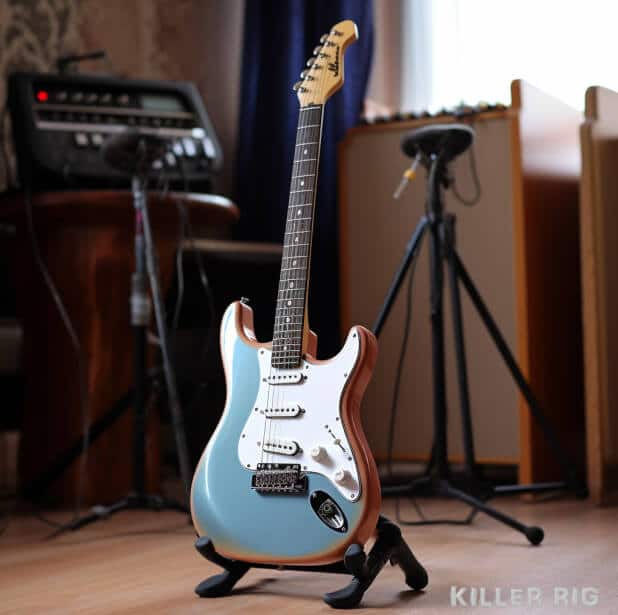Table of Contents
In the world of music, two stars often shine brightest for guitarists. Acoustic and electric guitars. Both share a common DNA, yet they’re worlds apart.
Think of the acoustic guitar. It’s raw, authentic, and intimate. It’s the sound of a campfire, a quiet café, or a beginner’s first strum.
Now, consider the electric guitar. It’s bold, amplified, and electrifying. It’s the heartbeat of rock ‘n’ roll, the lead in a blues band, and a tool for those who want to push musical boundaries.
Understanding these differences is key, and this Killer Rig article will help do just that. It’s not just about the physical or the scientific. It’s about the soul, the purpose, and the musical doors each one opens.
Quick Summary
Acoustic Guitar Benefits:
- Doesn’t require any additional equipment to produce sound.
- The hollow body amplifies the vibrations from the strings, creating a rich, full sound.
- Variety of shapes and sizes: From jumbo to mini, each shape and size contributes to the guitar’s unique tonal characteristics.
- The type of wood used for the body, neck, and fretboard significantly influences the sound and feel of the instrument.
Electric Guitar Benefits:
- Relies on an amplifier to produce sound, allowing for greater volume and control.
- The electric signal from the strings can be manipulated using pedals and other equipment, offering a wide range of tones and effects.
- Typically has a thinner neck and lighter gauge strings, making it generally easier to play.
- The choice of wood, pickups, and hardware can all influence the sound and playability of an electric guitar.

Acoustic Vs Electric Guitars
Getting right into the heart of the matter, let’s unravel the fundamental differences between acoustic and electric guitars.
Let’s start with the acoustic guitar. Its body is hollow, designed to resonate when the strings vibrate. This natural amplification creates a rich, full-bodied sound that can fill a room without any external help.
Now, the electric guitar. Its body is solid, and it relies on electricity to make its voice heard. When you strum its strings, magnetic pickups convert the vibrations into electric signals.
These signals then travel to an amplifier, which boosts them into the powerful, versatile sounds that electric guitars are famous for.
Watch this YouTube video to get an idea in real time!
Differences in Playing Techniques
Acoustic
Acoustic guitars are a bit more demanding. With thicker strings and wider necks, they require strength and endurance. Techniques like fingerpicking and sliding demand dexterity.
Tough for beginners? I mean, they can be, depending on your hand size and a few other factors. But the satisfaction level when you nail that chord is top shelf!
There are also many different kinds of acoustic guitars. Some with nylon strings that have different techniques and can be easier on your fingertips. This gives guitar players some great options.
Electric
Now, electric guitars are not quite as demanding. Thinner strings, narrower necks, they’re built for speed and ease. Techniques like bending and palm muting are common. And then there’s the world of effects pedals.
Distortion, delay, reverb, it’s a sonic smorgasbord. Can be overwhelming when you’re getting started, but the thrill of exploring new sounds is undeniable.
If you like bands or artists that play an electric guitar now, you will eventually find yourself here anyway. The fact remains, the music you listen to will lead you to the instrument you always wanted to play, the techniques you desire to learn.
What About Guitar Chords?
Even though the electric and acoustic guitars both have some original techniques that they are better for, doesn’t mean that everything is different. Guitar chords for example are exactly the same between both instruments.
As long as you have them tuned the same, let’s say standard E-A-D-G-B-E, then the chord shapes can be used in the same ways. So guitarists can change between the electric and acoustic guitar when they want to play some of their favorite songs.

Differences in Sound and Music Styles
Let’s explore the sonic worlds and musical styles of acoustic and electric guitars, with a little help from some iconic artists.
Acoustic guitars are the heart and soul of folk, country, and blues. Think Bob Dylan, with his raw, lyrical storytelling. Or Taylor Swift’s early country albums, where her acoustic guitar took center stage. The sound of an acoustic is warm, rich, and organic.
For a singer-songwriter, the acoustic guitar is undeniably one of the most popular instruments. Plus, campfire songs are played on only an acoustic guitar because of their natural sound, hard-pressed to be found in any other platform.
Here is a sound sample of an acoustic guitar featuring the warm, organic sound I touched on:
Electric guitars, meanwhile, are the rock stars. They’re all about variety and power. Think Jimi Hendrix, with his explosive, feedback-drenched solos. Or The Edge from U2, with his echo-laden, atmospheric riffs.
With amplifiers and effects, electric guitars can go from the jangly pop of The Beatles to the heavy crunch of Metallica. They’re bold, definitely loud, and are not afraid to push boundaries!
In this sound sample, you will hear an electric guitar with a distorted tone, one that has shaped our music today:
Genres for Acoustic and Electric Guitars
To give you an idea, here are some genres typically associated with each type of guitar:
Acoustic Guitar Genres:
- Folk
- Country
- Blues
- Singer-Songwriter
- Classical or Flamenco
- Slide Guitar
- Bluegrass
Electric Guitar Genres:
- Rock
- Metal
- Jazz
- Pop
- Blues
- Punk
- Funk
Remember, these are not hard-and-fast rules. Many artists successfully bend and break these norms, creating their own sounds. The goal is to select an instrument that aligns with your musical tastes and inspires you to play.
Differences in Equipment and Accessories
Let’s now turn our attention to the equipment and accessories that accompany acoustic and electric guitars.
Acoustic guitars are beautifully self-sufficient. No amplifiers or cables required. You can simply cradle it in your arms and strum away. Yet, they do have a few complementary accessories. Take the capo, for instance.
This nifty little device clamps onto the guitar neck, altering the pitch of the strings. It’s like having a key changer at your fingertips, letting you shift musical gears without relearning chord shapes.
You can also get what’s called a slide. This tube-like apparatus slips over your finger and lets you slide it along the strings. The gliding sound it makes is found nowhere else!
Electric guitars, on the other hand, are a bit like complex high-tech gadgets. They need an amplifier to be heard, and cables to connect everything. And then there’s the world of guitar effects. Distortion, delay, reverb, chorus, and the list goes on.
Each pedal can dramatically alter the sound of the guitar, offering endless possibilities. And let’s not forget about the whammy bar, a lever attached to the bridge that can change the pitch of the notes being played, creating a vibrato or dive bomb effect.
Both have their own set of tools and toys, but they require different levels of preparation and setup.

Differences in Cost and Portability
Acoustic guitars are often the more economical choice. They’re generally cheaper to buy, and since they don’t require an amplifier or other equipment, the initial investment is lower.
With electric guitars the initial cost is typically higher, and that’s before you add in the amplifier, cables, and effects pedals. Yet, what you get in return is a versatile instrument capable of a wide array of sounds.
Yet, they offer different experiences and call for varying degrees of investment. Below you will find a table with some prices of beginner acoustic and electric guitars for comparison:
| Model | Type | Price |
|---|---|---|
| Yamaha JR1 | Acoustic | $160.00 |
| Epiphone DR-100 | Acoustic | $170.00 |
| Squier Sonic Telecaster | Electric | $200.00 |
| Epiphone SG Special | Electric | $200.00 |
Is One Harder to Tune?
So now that we have looked at so many of the differences, you must be thinking that one is probably harder to tune?
But here is one important similarity that they both share. They tune exactly the same! That’s right, once you learn how to tune one, you can do the other.
Now, this is assuming they are using the same tuning, like drop D for example. You can then jump from one to the other and practice all the same.
It’s also important to consider that they are also all 6-string guitars. Anything beyond this will require a different tuning arrangement.
Is Acoustic or Electric Better for Beginners?
A study run by the National Guitar Academy in 2018 discovered that out of every ten beginners, roughly six leaned towards strumming on the acoustic. The rest, about four in ten, chose to electrify their learning with an electric guitar.
Why are acoustic guitars the popular choice among beginners? They’re generally easier to get, and you don’t need as much gear as you would for their electric counterparts. But that doesn’t necessarily make them the superior choice for all newbies.
Now, let’s flip the coin. Electric guitars also have their charm for new learners. Their alluring versatility and the breadth of tones they can churn out is a significant draw.
Yet, for some, nothing beats the traditional, warm melodies that flow from an acoustic guitar. So, the choice largely hangs on personal preference and which guitar feels better to the guitarist.
Conclusion
Choosing between an acoustic and electric guitar is a personal decision. It’s one that depends on a whole wack of factors! Your musical interests, your comfort and playability requirements, the sounds that inspire you, and the size that suits you best.
It’s about finding a guitar that feels like a part of your own body! And one that leads you closer to your musical vision and creativity.
Ultimately, learning guitar is rewarding. Take your time, explore your options, and let your intuition guide your decision.
FAQ
Does Acoustic Guitar Hurt Your Fingers More Than Electric?
Yes, typically, playing an acoustic can be more challenging on your fingers compared to an electric guitar.
This is primarily due to the thicker gauge strings and higher string action found on most acoustic guitars. These factors can make pressing down on the strings harder, which may lead to sore fingertips, especially for beginners.
However, with regular practice, your fingers will develop calluses, reducing the discomfort over time.
Electric guitars, with their thinner strings and lower action, require less finger pressure, making them a bit more comfortable to play, particularly for extended periods.
Is it OK to start with an electric guitar?
Absolutely! Starting with an electric guitar is perfectly fine, especially if you prefer the music you can make with it. The benefits of building finger strength and exterity are still possible with the electric.
Plus, most of the learning material available are for both acoustic and electric guitars. The chords are all the same, and so is much of the technique. But the main thing to always consider is the music style so that you can remain inspired.

